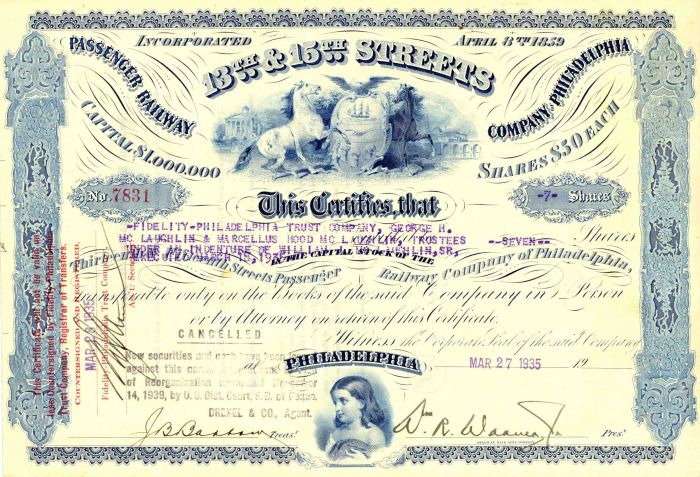13th and 15th Streets Passenger Railway - Railroad Stock Certificate - Thirteenth and Fifteenth Streets
Inv# RS2806 Stock
Superb vignettes by American Bank Note Co.
Application having been made to the Legislature for a charter for a railroad company to ply between Philadelphia and Norristown, an act was passed on February 17, 1831, incorporating the Philadelphia, Germantown and Norristown railroad. Eight thousand shares at fifty dollars each were authorized to be issued. the stock was quickly over-subscribed. Rails were laid to Germantown and the road was formally opened on June 6, 1832. The first car drawn by horses left the depot, corner Ninth and Green streets, at 12:15 P.M. arriving in Germantown three-quarters of an hour later, which was considered great speed. Cars left the depot at intervals of two hours. Fare twenty-five cents. For six months horse-power was used. On November 23, 1832, a great novelty was introduced in the shape of a locomotive engine, which had been built by Matthias W. Baldwin. the engine ran beyond the township line at a speed of about twenty-eight miles per hour. On the following day the locomotive drew four cars loaded with passengers to Germantown, a distance of six mile, in twenty-eight minutes. by act of March 1, 1833, the company was authorized to build a single track on Ninth Street from Spring Garden Street to Vine Street.
In April, 1829, the Delaware and Schuylkill Railroad was incorporated. This railroad was finished and opened on April 23, 1834. The route of same was on Willow Street, from the Delaware River westward to Broad Street to Pennsylvania Avenue, to the Schuylkill river bridge at Peters' Island, there to connect with the Columbia or Pennsylvania Railroad. It was practically the first passenger railroad within the city. The cars were drawn by horses. It was announced that on this date pleasure cars would run at stated periods from the Third Street Hall, northwest corner of third and Willow Streets. This building was erected to serve a dual purpose-hotel and railroad depot.
Philadelphia and Trenton Railroad was incorporate February 23, 1832, with a capital of six hundred thousand dollars. The depot was established on a lot of ground between Frankford Road and Front Street, north of Harrison (now Palmer Street). The office of the company to continue east at Third Street Hall, Third and Willow Streets, On March 23, 1839, another act of assembly was passed authorized the company to continue its tracks from the depot in Kensington along the Frankford Road and Maiden Street for one year, until another railroad could be conveniently constructed upon another route from the Kensington depot to the depot at Third and Willow Streets.
The Philadelphia and Reading Railroad Company's charter was passed April 4, 1833. The original object of the company was to construct a railroad from Peter's Island, four miles from Philadelphia, where connection was made with the Philadelphia and Columbia Railroad to Reading, a distance of fifty-four miles. Portions of the road were opened for travel in 1835. The port Richmond branch, five miles long, from Port Richmond branch, five miles long, from Port Richmond on the Delaware to the Falls of Schuylkill was completed in 1842. After the State Railroad was relocated, in 1850, the old line from Thirteenth and Callowhill Streets, Philadelphia, to Peters' Island, was purchased by the Philadelphia and Reading Railroad Company.
A subsidiary company was The Laurel Run Improvement Company, chartered May 18, 1871, and changed by act of December 12, 1871, to the Philadelphia and Reading Coal and Iron Company.
North Pennsylvania Railroad. In 1851 considerable interest was manifest for the construction of a railroad connecting Philadelphia with the Lehigh coal region. This resulted in the incorporation on April 8, 1852, of the Philadelphia, Easton and Water Gap Railroad Company. The title of the company was changed by act of April 18, 1853, to the North Pennsylvania Railroad Company. It was formally opened Monday, July 2, 1855, by an excursion from the Cohoquinoque Station, at Front and Willow Streets, to Fort Washington. The road was opened through to Bethlehem in 1857. The passenger depot remained at Front and Willow Streets until 1864, when it was removed to Germantown Road, above Thompson Street (later used as the Milk Depot). Subsequently s depot was built at Third and Berks Streets. The North Pennsylvania Railroad is now a part of the Reading Railway system.
The Pennsylvania Railroad. This road grew out of the mixed railroad and canal system constructed by the State between Philadelphia and Pittsburgh. On the 13th of April, 1846, an act to incorporate the Pennsylvania Railroad was passed. The capital stock of the company was fixed at $7,500,000 with the privilege of increasing same to $10,000,000. During the year of 1847 the city of Philadelphia subscribed $2,500,000 to the stock of the company. The next year the county of Allegheny subscribed $1,000,000. Much of the success attending the Pennsylvania Railroad is due to the almost military rigidity with which its workings were arranged under the inspiration of its chief engineer and first president, J. Edgar Thompson. For Twenty years he marked out and reiterated in his annual reports the plan for the future of the Pennsylvania Railroad, and he never deviated from that plan, pursuing it persistently, patiently and faithfully. (From UShistory.org)
A stock certificate is issued by businesses, usually companies. A stock is part of the permanent finance of a business. Normally, they are never repaid, and the investor can recover his/her money only by selling to another investor. Most stocks, or also called shares, earn dividends, at the business's discretion, depending on how well it has traded. A stockholder or shareholder is a part-owner of the business that issued the stock certificates.









Ebay ID: labarre_galleries